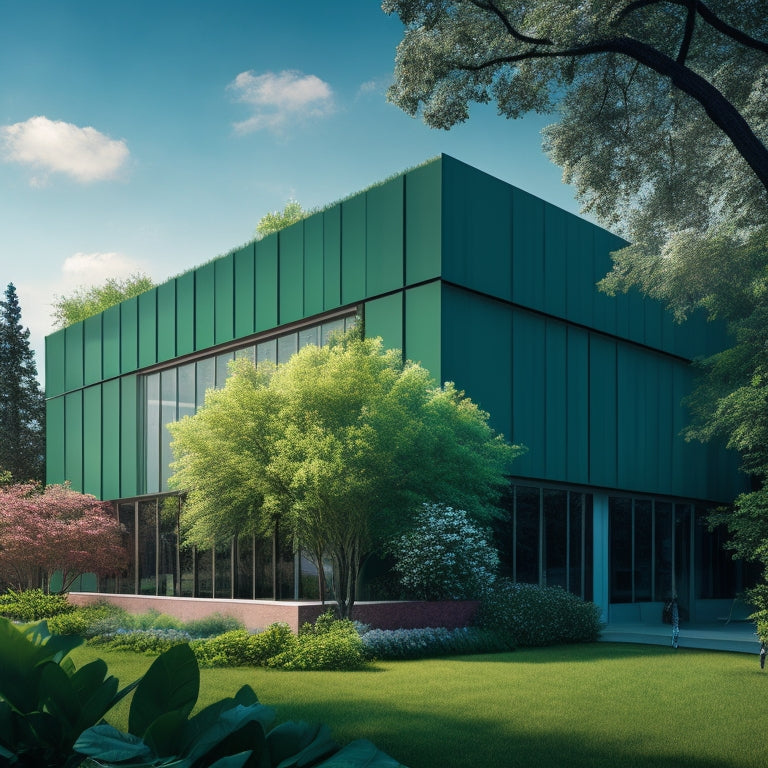
What Upgrades Boost Building Energy Efficiency Fastest?
Share
You can greatly reduce your building's energy consumption and carbon footprint by targeting specific upgrades that yield the fastest and most impactful results. LED lighting retrofits, for instance, can cut energy consumption by up to 75%. Proper duct sealing and upgrading to high-efficiency air filtration systems can also reduce energy waste. Additionally, double-glazed windows, wall insulation, and smart building automation systems can significantly minimize energy losses. By prioritizing these upgrades, you'll be well on your way to maximizing your building's energy efficiency. Now, discover the best order and implementation strategies to achieve the greatest impact.
Key Takeaways
• LED lighting upgrades can cut energy consumption by up to 75% with optimal luminaire retrofits and task lighting strategies.
• Proper duct sealing and high-efficiency air filtration systems can reduce HVAC energy losses by up to 30%.
• Double-glazed windows with low-e coatings can minimize energy losses and reduce heat transfer by up to 90%.
• Insulation upgrades, such as fiberglass and spray foam, can reduce heat loss by up to 90% when installed correctly.
• Smart building automation systems with real-time monitoring and data analytics can optimize energy usage and reduce waste.
Lighting Upgrades for Maximum Impact
By replacing traditional incandescent bulbs with LEDs, you can cut energy consumption by up to 75% and greatly reduce your building's carbon footprint. This significant reduction is achievable through strategic lighting upgrades.
Luminaire retrofits, for instance, can be implemented to optimize lighting performance while minimizing energy waste. Additionally, task lighting strategies can be employed to focus light only where it's needed, reducing unnecessary energy expenditure.
HVAC System Energy Efficiency Boost
As you shift your focus from lighting to heating, ventilation, and air conditioning (HVAC) systems, you'll find opportunities to further optimize energy efficiency by implementing advanced technologies and strategies that minimize energy waste and reduce your building's environmental impact.
One important step is to guarantee proper duct sealing, as leaky ducts can account for up to 30% of energy losses. Additionally, upgrading to high-efficiency air filtration systems can notably reduce energy consumption.
By incorporating these upgrades, you'll not only reduce energy waste but also improve indoor air quality and overall system performance.
Window Replacements for Energy Savings
When considering window replacements for energy savings, you'll want to explore options that minimize heat transfer and reduce energy loss.
Double-glazed windows, for instance, offer improved thermal insulation by trapping a layer of air between two panes of glass.
Additionally, you'll want to evaluate energy-efficient glass options that can further reduce heat gain and loss, such as low-e coatings or tinted glass.
Double-Glazed Window Benefits
You can greatly reduce heat transfer and energy losses by replacing old, single-pane windows with double-glazed windows, which feature two panes of glass separated by a gap of air or gas. This upgrade not only reduces heat transfer but also provides soundproofing benefits, minimizing external noise and creating a more peaceful indoor environment.
Double-glazed windows also offer aesthetic appeal, with a sleek and modern design that enhances your building's exterior. Additionally, the gap between the panes can be filled with gas, such as argon or krypton, which further reduces heat transfer and energy losses.
Energy-Efficient Glass Options
When evaluating energy-efficient glass options, you'll want to explore low-e coatings that minimize heat transfer and reduce thermal bridging.
Thermal bridging occurs when heat escapes through the window frame, decreasing the overall insulating performance.
To address this, look for glass coatings with low emissivity, which can decrease heat transfer by up to 70%.
Additionally, think about utilizing warm-edge spacers that reduce thermal bridging and minimize heat loss.
Insulation Upgrades for Reduced Loss
As you consider insulation upgrades for reduced energy loss, you'll need to evaluate wall insulation options that suit your building's specific needs.
Proper placement of insulation is vital, and you'll want to make sure it's installed correctly to maximize its effectiveness.
Wall Insulation Options
Properly installed wall insulation can reduce heat loss through walls by up to 90%, making it an essential component of an energy-efficient building envelope.
You have several options to choose from, each with its benefits. Fiberglass insulation, a popular choice, offers several benefits, including low cost, ease of installation, and high R-value per dollar.
Spray applications, such as spray foam insulation, provide a high R-value and can be applied to irregularly shaped areas. They also offer excellent air-tightness and can help reduce air leaks.
When selecting a wall insulation, consider factors such as climate, budget, and personal preferences to determine the most suitable option for your building. By choosing the right insulation, you can significantly reduce heat loss and energy consumption, leading to a more energy-efficient building.
Proper Insulation Placement
When placing insulation, you must guarantee it's installed correctly to maximize its energy-saving potential, as even slight gaps or misalignments can greatly reduce its effectiveness. Proper insulation placement is essential to achieving peak energy efficiency.
Here are some key considerations to keep in mind:
-
Insulation Material: Choose the right insulation material for your building type and climate zone.
-
Installation Techniques: Make sure that insulation is installed using proper techniques, such as cutting it to fit snugly around obstructions.
-
Seal Air Leaks: Seal all air leaks and gaps around electrical outlets, windows, and doors to prevent heat loss.
- Verify Coverage: Verify that all areas requiring insulation are properly covered to prevent energy loss.
Smart Building Automation Systems
You can greatly enhance building energy efficiency by integrating smart building automation systems that optimize energy usage through real-time monitoring and control of various building systems. These systems utilize data analytics to identify areas of inefficiency and provide actionable insights for improvement.
With smart automation, you can optimize energy consumption, reduce waste, and minimize your building's carbon footprint. However, it's important to take into account cybersecurity risks when implementing these systems, as they can be vulnerable to hacking and data breaches. By prioritizing cybersecurity measures, you can safeguard the integrity of your building's systems and data.
Energy-Efficient Roofing Solutions
Implementing energy-efficient roofing solutions can greatly reduce heat gain during summer and heat loss during winter, leading to substantial energy savings and a decreased reliance on HVAC systems.
You can take control of your building's energy efficiency by incorporating the following solutions:
-
Solar panels: Integrating solar panels into your roofing system can generate electricity and reduce your reliance on the grid.
-
Cool membranes: Applying cool membranes can reflect solar radiation, reducing heat gain and energy consumption.
-
Green roofs: Plant-covered roofs provide insulation, reduce stormwater runoff, and create habitats for wildlife.
- Radiative barriers: Installing radiative barriers can reflect heat rather than absorb it, reducing energy consumption and costs.
Frequently Asked Questions
What Is the Average ROI on Energy-Efficient Building Upgrades?
You can expect an average ROI of 15-20% on energy-efficient building upgrades, yielding substantial cost savings and financial benefits, as reduced energy consumption directly translates to increased profitability.
Can Energy-Efficient Upgrades Increase a Building's Resale Value?
When you upgrade to energy-efficient features, you can increase your building's resale value by 10-15%. Appraisal methods consider buyer preferences for eco-friendly features, and neighborhood trends show buyers willing to pay a premium for sustainable buildings.
How Do I Prioritize Energy-Efficient Upgrades on a Limited Budget?
To prioritize energy-efficient upgrades on a limited budget, you'll want to conduct a thorough cost analysis and optimize upgrade sequencing, focusing on high-impact, cost-effective measures that maximize ROI and energy savings.
Are Energy-Efficient Building Upgrades Eligible for Government Incentives?
You can leverage government incentives for energy-efficient building upgrades, such as tax credits and grant programs, to offset costs; research and explore available options to maximize your budget's impact.
Can Energy-Efficient Upgrades Reduce a Building's Carbon Footprint?
You'll be surprised to know that buildings account for 39% of global carbon emissions! By implementing energy-efficient upgrades, you can notably reduce a building's carbon footprint, achieving substantial carbon savings and environmental benefits, ultimately contributing to a more sustainable future.
Related Posts
-

3 Earth-Loving Furniture Tips for Energy-Smart Homes
When furnishing your energy-smart home, you have the power to reduce your carbon footprint greatly by making consciou...
-

Why EVs Inspire Earth-Conscious Home Design Choices
As you shift to an electric vehicle, you're not just switching to a greener ride, you're igniting a broader commitmen...
-

10 Powerful Electric Mowers for Expansive Lawns
You're moving away from gas-powered mowers and exploring electric options for your expansive lawn. You'll find that h...


